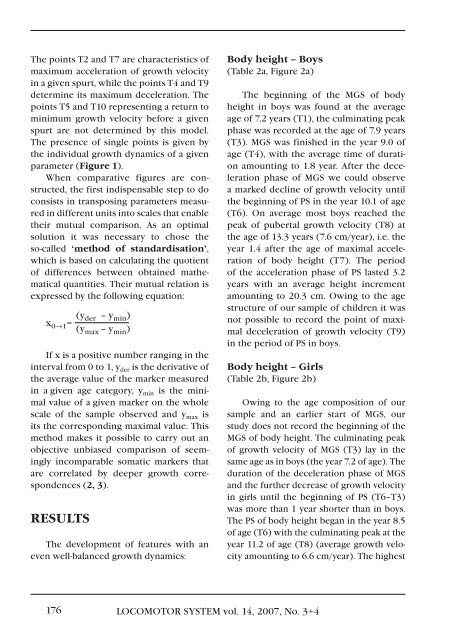Ortopedická protetika Praha sro - Společnost pro pojivové tkáně
Ortopedická protetika Praha sro - Společnost pro pojivové tkáně
Ortopedická protetika Praha sro - Společnost pro pojivové tkáně
Create successful ePaper yourself
Turn your PDF publications into a flip-book with our unique Google optimized e-Paper software.
The points T2 and T7 are characteristics of<br />
maximum acceleration of growth velocity<br />
in a given spurt, while the points T4 and T9<br />
determine its maximum deceleration. The<br />
points T5 and T10 representing a return to<br />
minimum growth velocity before a given<br />
spurt are not determined by this model.<br />
The presence of single points is given by<br />
the individual growth dynamics of a given<br />
parameter (Figure 1).<br />
When comparative figures are constructed,<br />
the first indispensable step to do<br />
consists in transposing parameters measured<br />
in different units into scales that enable<br />
their mutual comparison. As an optimal<br />
solution it was necessary to chose the<br />
so-called ‘method of standardisation’,<br />
which is based on calculating the quotient<br />
of differences between obtained mathematical<br />
quantities. Their mutual relation is<br />
expressed by the following equation:<br />
x 0→1 = (y der – y min )<br />
(y max – y min )<br />
If x is a positive number ranging in the<br />
interval from 0 to 1, y der is the derivative of<br />
the average value of the marker measured<br />
in a given age category, y min is the minimal<br />
value of a given marker on the whole<br />
scale of the sample observed and y max is<br />
its the corresponding maximal value. This<br />
method makes it possible to carry out an<br />
objective unbiased comparison of seemingly<br />
incomparable somatic markers that<br />
are correlated by deeper growth correspondences<br />
(2, 3).<br />
RESULTS<br />
The development of features with an<br />
even well-balanced growth dynamics:<br />
176<br />
Body height – Boys<br />
(Table 2a, Figure 2a)<br />
The beginning of the MGS of body<br />
height in boys was found at the average<br />
age of 7.2 years (T1), the culminating peak<br />
phase was recorded at the age of 7.9 years<br />
(T3). MGS was finished in the year 9.0 of<br />
age (T4), with the average time of duration<br />
amounting to 1.8 year. After the deceleration<br />
phase of MGS we could observe<br />
a marked decline of growth velocity until<br />
the beginning of PS in the year 10.1 of age<br />
(T6). On average most boys reached the<br />
peak of pubertal growth velocity (T8) at<br />
the age of 13.3 years (7.6 cm/year), i.e. the<br />
year 1.4 after the age of maximal acceleration<br />
of body height (T7). The period<br />
of the acceleration phase of PS lasted 3.2<br />
years with an average height increment<br />
amounting to 20.3 cm. Owing to the age<br />
structure of our sample of children it was<br />
not possible to record the point of maximal<br />
deceleration of growth velocity (T9)<br />
in the period of PS in boys.<br />
Body height – Girls<br />
(Table 2b, Figure 2b)<br />
Owing to the age composition of our<br />
sample and an earlier start of MGS, our<br />
study does not record the beginning of the<br />
MGS of body height. The culminating peak<br />
of growth velocity of MGS (T3) lay in the<br />
same age as in boys (the year 7.2 of age). The<br />
duration of the deceleration phase of MGS<br />
and the further decrease of growth velocity<br />
in girls until the beginning of PS (T6–T3)<br />
was more than 1 year shorter than in boys.<br />
The PS of body height began in the year 8.5<br />
of age (T6) with the culminating peak at the<br />
year 11.2 of age (T8) (average growth velocity<br />
amounting to 6.6 cm/year). The highest<br />
LOCOMOTOR SYSTEM vol. 14, 2007, No. 3+4

















